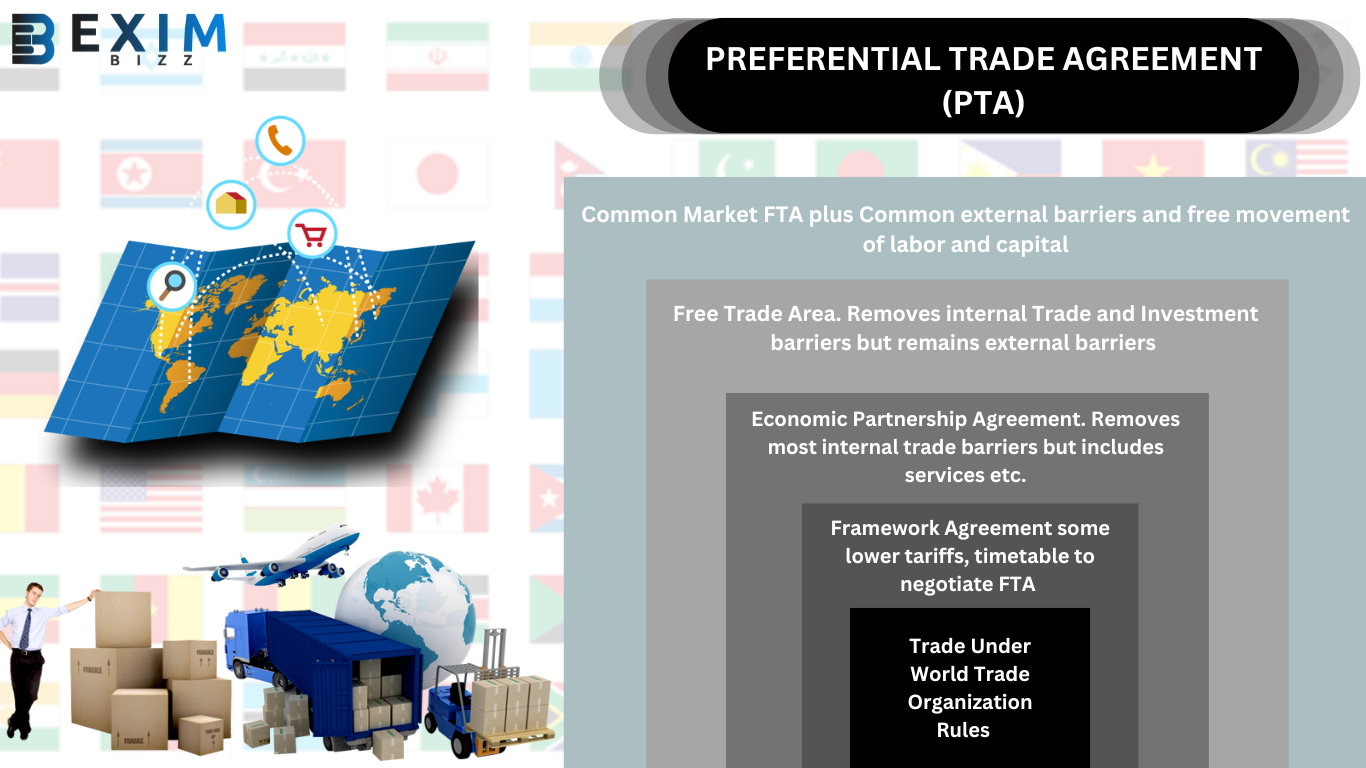In today’s interconnected global economy, countries are increasingly seeking ways to enhance trade relations and economic growth. One of the key mechanisms through which this is achieved is Preferential Trade Agreements (PTAs). India, as a rapidly growing economy, has actively engaged in PTAs to expand its trade footprint and strengthen its position in the global market. In this blog, we will explore what preferential trade agreements are, how they work, their benefits for India, and where you can stay updated on new rules and regulations.
What Are Preferential Trade Agreements (PTAs)?
A Preferential Trade Agreement (PTA) is a trade pact between two or more countries that grants preferential access to certain products by reducing or eliminating tariffs and other trade barriers. Unlike free trade agreements (FTAs), which aim for comprehensive trade liberalization, PTAs are often narrower in scope and focus on specific sectors or products. They serve as stepping stones toward deeper economic integration.
India has signed several PTAs with countries and regional blocs to promote exports, attract investments, and diversify its trade portfolio. These agreements allow Indian businesses to access foreign markets at reduced costs, making their goods and services more competitive internationally.
How Do PTAs Work?
The functioning of PTAs involves several key elements:
- Tariff Reductions: Under PTAs, participating countries agree to lower or eliminate tariffs on specific goods traded between them. For example, India’s PTA with ASEAN countries under the India-ASEAN Trade in Goods Agreement provides duty-free access to many products.
- Rules of Origin : To ensure that only goods originating from member countries benefit from preferential treatment, strict rules of origin are established. These rules specify the minimum level of local content required for a product to qualify for tariff concessions.
- Quotas and Safeguards : Some PTAs include quotas to limit the volume of imports eligible for preferential treatment. Additionally, safeguard measures may be implemented if imports surge unexpectedly, threatening domestic industries.
- Dispute Resolution Mechanisms: PTAs typically have provisions for resolving disputes related to implementation or interpretation of the agreement, ensuring transparency and fairness.
- Sectoral Focus : Many PTAs target specific sectors such as textiles, pharmaceuticals, agriculture, or IT services, aligning with the comparative advantages of the participating countries.
India has signed PTAs, Free Trade Agreements (FTAs), Comprehensive Economic Partnership Agreements (CEPAs), and other trade deals with various countries and regional blocs. Below is a list of key partners:
1. ASEAN (Association of Southeast Asian Nations)
- Countries: Brunei, Cambodia, Indonesia, Laos, Malaysia, Myanmar, Philippines, Singapore, Thailand, Vietnam.
- Agreement: India-ASEAN Trade in Goods Agreement (2009).
- Key Benefits for Exporters:
- Duty-free or reduced tariffs on a wide range of goods, including textiles, pharmaceuticals, machinery, and automotive components.
- Increased market access to one of the fastest-growing economic regions in the world.
- Opportunities to integrate into ASEAN supply chains, especially in electronics and manufacturing.
2. South Korea
- Agreement: Comprehensive Economic Partnership Agreement (CEPA) (2010).
- Key Benefits for Exporters:
- Tariff reductions on Indian exports like petroleum products, chemicals, gems, and jewelry.
- Enhanced cooperation in sectors such as IT, pharmaceuticals, and engineering services.
- Access to South Korea’s advanced technology and R&D collaborations.
3. Japan
- Agreement: Comprehensive Economic Partnership Agreement (CEPA) (2011).
- Key Benefits for Exporters:
- Reduced tariffs on Indian exports, including seafood, textiles, and leather goods.
- Opportunities for Indian companies in Japan’s high-tech and automotive industries.
- Encouraging investments and collaborative business ventures between Indian and Japanese companies.
4. Singapore
- Agreement: Comprehensive Economic Cooperation Agreement (CECA) (2005).
- Key Benefits for Exporters:
- Duty-free access for Indian exports like petroleum products, textiles, and gems.
- Simplified customs procedures and faster clearance of goods.
- Gateway to Southeast Asia’s markets through Singapore’s strategic location.
5. Sri Lanka
- Agreement: India-Sri Lanka Free Trade Agreement (ISFTA) (2000).
- Key Benefits for Exporters:
- Duty-free access for Indian goods such as pharmaceuticals, automobiles, and agricultural products.
- Strengthened ties with a neighboring country, promoting regional trade.
- Opportunities for small-scale exporters to tap into Sri Lanka’s growing consumer market.
6. Nepal and Bhutan
- Agreement: Bilateral trade agreements under SAFTA (South Asian Free Trade Area).
- Key Benefits for Exporters:
- Duty-free access for Indian goods across multiple sectors.
- Boost to exports of agricultural products, textiles, and FMCG goods.
- Enhanced regional integration within South Asia.
7. Mauritius
- Agreement: India-Mauritius Comprehensive Economic Cooperation and Partnership Agreement (CECPA) (2021).
- Key Benefits for Exporters:
- Tariff concessions on Indian exports like food products, textiles, and pharmaceuticals.
- A platform to expand into Africa via Mauritius, which serves as a hub for trade and investment in the region.
- Opportunities for Indian service providers in sectors like IT, education, and healthcare.
8. United Arab Emirates (UAE)
- Agreement: Comprehensive Economic Partnership Agreement (CEPA) (2022).
- Key Benefits for Exporters:
- Reduced tariffs on Indian exports such as textiles, gems and jewelry, food items, and pharmaceuticals.
- Access to UAE’s strategic ports and logistics infrastructure.
- Strengthened trade relations with a major re-export hub for the Middle East and Africa.
9. Australia
- Agreement: India-Australia Economic Cooperation and Trade Agreement (ECTA) (2022).
- Key Benefits for Exporters:
- Duty-free access for Indian textiles, leather goods, and gemstones.
- Opportunities for Indian service providers in education, healthcare, and IT.
- Access to Australia’s agricultural and mining sectors for collaboration.
10. European Free Trade Association (EFTA)
- Countries: Iceland, Liechtenstein, Norway, Switzerland.
- Agreement: India-EFTA Trade Agreement (under negotiation).
- Potential Benefits for Exporters:
- Expected tariff reductions on Indian pharmaceuticals, textiles, and engineering goods.
- Access to high-income European markets with strong demand for quality goods.
11. Other Regional Blocs
- Asia-Pacific Trade Agreement (APTA): Includes Bangladesh, China, Laos, Mongolia, South Korea, and Sri Lanka.
- Benefits: Tariff concessions on a wide range of goods, fostering intra-regional trade.
- BIMSTEC (Bay of Bengal Initiative for Multi-Sectoral Technical and Economic Cooperation): Comprises Bangladesh, Bhutan, Myanmar, Nepal, Sri Lanka, and Thailand.
- Benefits: Focus on energy, transport, and trade facilitation among member nations.
Key Benefits for Indian Exporters Under PTAs
- Tariff Reductions:
- Exporters enjoy reduced or zero tariffs on eligible goods, making their products more competitive in foreign markets.
- Market Access:
- PTAs open up new markets by providing preferential access to participating countries, helping Indian businesses diversify their export destinations.
- Cost Savings:
- Lower tariffs translate to cost savings for exporters, improving profit margins and enabling them to offer competitive pricing.
- Increased Competitiveness:
- Indian exporters gain an edge over competitors from non-member countries due to favorable trade terms.
- Encouragement for MSMEs:
- Small and medium enterprises (MSMEs) benefit significantly as they can now affordably enter international markets.
- Supply Chain Integration:
- Businesses can integrate into global value chains, particularly in regions like ASEAN, where production networks are highly interconnected.
- Diversification of Exports:
- Exporters can explore new product categories and sectors supported by PTAs, reducing dependence on traditional exports.
- Strengthened Diplomatic Ties:
- Trade agreements foster stronger political and economic relationships, creating a conducive environment for business growth.
- Technology Transfer and Innovation:
- Collaborations facilitated by PTAs often lead to knowledge sharing and technological advancements, benefiting Indian industries.
- Risk Mitigation:
- By expanding into multiple markets, exporters reduce risks associated with reliance on a single trading partner.
How Can Exporters Leverage These Agreements?
To fully benefit from PTAs, Indian exporters should:
- Understand Rules of Origin: Ensure compliance with origin requirements to qualify for tariff concessions.
- Obtain Necessary Certificates: Apply for certificates like Certificate of Origin (COO) to avail preferential treatment.
- Explore New Markets: Identify untapped opportunities in PTA partner countries.
- Engage with Trade Bodies: Collaborate with organizations like FIEO, CII, and ASSOCHAM for guidance and support.
- Monitor Updates: Stay informed about changes in rules and regulations through DGFT, Ministry of Commerce, and embassy websites.
Staying Updated on New Rules and Regulations
To stay informed about updates regarding PTAs and related trade policies, consider the following resources:
- Directorate General of Foreign Trade (DGFT): The DGFT website (gov.in ) is the primary source for information on India’s trade agreements, including notifications, guidelines, and application procedures.
- Ministry of Commerce and Industry: Regularly publishes updates on ongoing negotiations, new agreements, and policy changes on its official portal (gov.in ).
- World Trade Organization (WTO): While not specific to India, the WTO website (org) provides insights into global trade trends and multilateral agreements.
- Embassy Websites: Official websites of Indian embassies abroad often share updates on trade agreements relevant to specific regions or countries.
- Trade Associations and Chambers of Commerce: Organizations like the Federation of Indian Export Organisations (FIEO) and Confederation of Indian Industry (CII) offer valuable insights and host events discussing trade developments.
- News Outlets and Business Journals: Publications like The Economic Times, Business Standard, and Financial Express frequently cover trade-related news and analysis.
- Customs and Excise Notifications: Keep an eye on customs notifications issued by the Central Board of Indirect Taxes and Customs (CBIC) for operational details affecting imports and exports.
List of Countries/Regions India Has PTAs With :
ASEAN, South Korea, Japan, Singapore, Sri Lanka, Nepal, Bhutan, Mauritius, UAE, Australia, EFTA, APTA, BIMSTEC.
Benefits for Indian Exporters:
- Tariff reductions leading to cost savings.
- Enhanced market access and competitiveness.
- Opportunities for MSMEs and supply chain integration.
- Diversification of exports and strengthened diplomatic ties.
Stay updated on rules and regulations via resources like DGFT, Ministry of Commerce, WTO, and industry associations.
By leveraging these agreements strategically, Indian exporters can unlock immense potential for growth and success in global markets.






